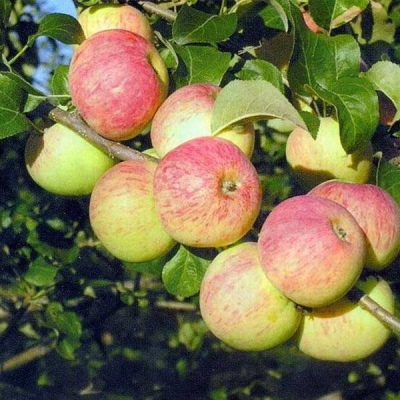
- Authors: NIISS Gorno-Altaysk, I.P. Kalinina, N.V. Ermakova, Z.S. Yashchemskaya
- Taste: sweet and sour
- Scent: pronounced
- Fruit weight, g: 92-130
- Fruit size: average
- Yield: for the first 3 years, the yield is 5.3 t / ha, at the age of 8 years -15.7 t / ha
- Frequency of fruiting: annual
- The beginning of fruiting varieties: for 4-5 years
- Ripening terms: late summer
- Removable maturity: end of August
The apple tree Tolunay is an expressive representative of the Altai selection. The plant has advanced much further in adapting to the conditions of the northern and cold regions than previous varieties. And therefore, the study of the features of this culture can be useful for gardeners in different regions.
Breeding history of the variety
The culture was developed in NIISS Gorno-Altaysk. The work on the varietal material was carried out by ZS Yashchemskaya, I. P. Kalinina, N. V. Ermakova. Basic grade - Altai Pepinka. He was crossed with a mixture of Welsey, Pepin Saffron and Bellefleur Chinese. Tolunay claims to be an elite variety, but the variety has not yet been fully studied, therefore any statements must be taken with considerable caution.
Description of the variety
The height of trees can reach 4 m. The rounded crown has an average density. Large and wide leaves are characteristic. A wrinkled surface is typical for them. Other features of the Tolunai apple tree:
- curved branches extending from the tree at an angle of 45 degrees or more;
- straight shoots of red-brown color with pubescence and a large number of miniature lentils;
- belonging to the medium-sized type.
Features, pros and cons
Under normal conditions, a tree does not grow taller than 2.5-3.5 m. The crown is extremely round and compact. Branches have to be pruned systematically. In adult apple trees, the branches can become spreading - their coverage exceeds 3 m. The peculiarities of the development of the branches make them afraid of breaking off under heavy load, which is stopped by tying and installing supports.
Tolunai's bark is either gray-brown or dark brown. Gradually, it cracks and may even begin to crumble. The root system is deep enough so that there is no risk even in severe frost. The presence or absence of a central core depends on the rootstock.
Ripening and fruiting
Apple tree Tolunay - late summer culture. Fruit ripeness is normally reached at the end of August. The consumer season starts in September. The first fruits are obtained in 4-5 years. From this moment, fruiting will go on annually.
Growing regions
Such an apple tree is zoned throughout the Siberian Federal District. Therefore, it can be safely cultivated in:
- Novosibirsk;
- Omsk;
- Kemerovo;
- Tomsk;
- The Tyumen region;
- Altai Territory.
Yield
At the very beginning of the fertile period, the collection is 13-15 kg. But in 7-9 years of development, the harvest will be 35 kg or more. The variety is self-fertile, and you can provide yourself with apples without the help of other trees. However, the presence of pollinators has a positive effect on fertility. If you bring in specially bees, you can even double the harvest.
Fruits and their taste
Tolunai apples are considered versatile fruits. Their surface is dominated by a golden yellow color. The fruit itself resembles a wide cone. There is ribbing, but it is not too pronounced.
Important information:
- fruit weight - from 0.092 to 0.13 kg;
- the average size;
- creamy pulp with sweet and sour taste;
- tender and juicy sensation;
- the skin is oily, has a waxy coating;
- serious, rich aroma;
- concentration of dry soluble components - up to 16.54%;
- the share of sugars - up to 13.23%;
- keeping quality level - up to 40 days.

Growing features
Stamb Tolunay tolerates low temperatures well. However, this plant is susceptible to drafts. Therefore, the importance of covering work cannot be underestimated. Both the bark and the kidneys are subject to freezing. The temperature is critical below -23 degrees. Scab resistance is very high - but if you only make mistakes in care and prevention, this disease flares up in full.
The Tolunai apple tree is susceptible to moniliosis, powdery mildew, and other pests that affect other varieties. The same applies to protection from rodents, from insect pests. It is undesirable to use clay and acidified areas. It is necessary to choose sunny, wind-protected spaces. Covering with walls, fences and other obstructions is very important.
Landing pits should be prepared in advance. The depth and diameter are the same - 0.8 m. It is necessary to take into account the size of the earth clod. Drainage is poured onto the bottom - gravel, vermiculite or nutshells. Row spacing should be at least 2.5 m, and the gap between individual trees should be at least 2 m.






The apple tree is a popular fruit crop among gardeners. It can be found in many summer cottages. But at the same time, such trees are often affected by various diseases. It is very important to recognize the disease in time and carry out the necessary procedures for a speedy recovery. Otherwise, the fruits will be spoiled, and the tree itself may die altogether.












































































